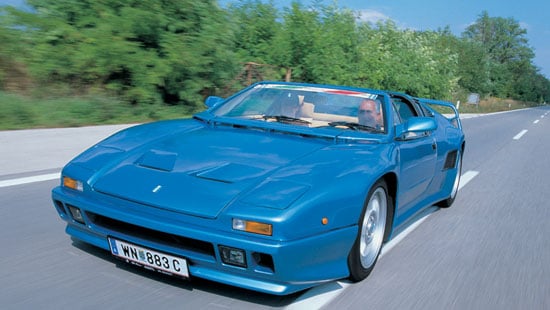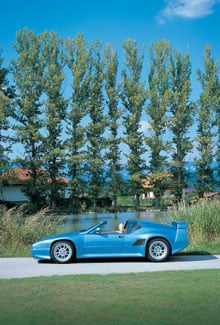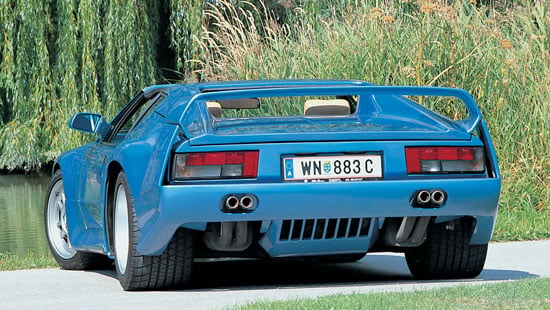
The following is an extract an article from December's Auto Italia magazine. For access to the full feature, plus articles on driving the Maserati GranSport, an Alfa SZ triple test, the 2004 Ferrari 275 Tour and much more, see www.auto-italia.co.uk
Like Colin Chapman, Alessandro De Tomaso played with the big boys. This meant being crafty, always clever and occasionally getting beaten up. During his early years when he focused on racing, like Chapman, De Tomaso developed a close link with Ford. As De Tomaso drifted into road car production he saw the marketing advantages of combining a svelte Italian body with good ol’ Cleveland iron.
Auto Italia travelled to Austria to drive De Tomaso’s greatest leap at mass production – the Pantera (panther). Not just any old Pantera, and not just one of the be-winged late model cars from the ’90s but an exceptionally rare late targa-top version. The Modena factory made 7260 Panteras between 1970 and 1990 – an amazing 20-year production span that was extended by three more years with 38 late-model 1990s Panteras. About 6000 went to the USA. Ford imported them between 1971-74. Some 1980s grey import GT5 and GT5-S models went to the USA but no 1990s Si Panteras
So why Austria? Franz and Gerda Krump, that’s why. Enthusiast Franz is on his eighth and ninth De Tomaso since 1979. Fabulously rare Pantera apart, the Krumps also drive a mint De Tomaso Guara (future test). Their stratos blue Pantera Si (chassis 9637) is one of only four with a targa roof and one of only two with a Getrag six-speed transaxle. Earlier cars came with a five-speed ZF unit as per the Ford GT40. Franz’s blue car was built in 1993 and was the show car at Paris, Brussels and Frankfurt. Franz bought the car in June 2003 with just 1000km (600 miles) on the clock. Before that, it had been registered in Germany for just one day before going on show in a Bavarian museum for six years. In Austria, customs have your pants down to the tune of 40% for importing a car (yes, Austria is in the EU but it’s still 40%). This tax has a fuel consumption element. The Green lobby is much stronger once you cross the Channel.
 The Pantera chassis has always been a steel monocoque construction with a mid-engined layout. The first models from 1970 produced 310bhp and weighed 1455kg (213bhp/tonne). In 1973 came the GTS still with the 5763cc Ford V8. Over the years, the factory offered three axle ratios (std 4.22:1, 4.02:1 and the so-called 175mph Le Mans axle with 3.77:1) and performance varied accordingly.
The Pantera chassis has always been a steel monocoque construction with a mid-engined layout. The first models from 1970 produced 310bhp and weighed 1455kg (213bhp/tonne). In 1973 came the GTS still with the 5763cc Ford V8. Over the years, the factory offered three axle ratios (std 4.22:1, 4.02:1 and the so-called 175mph Le Mans axle with 3.77:1) and performance varied accordingly.
The 1990s cars came with a modern, smaller, lighter, fuel-injected, catalysed 5.0-litre Ford V8 producing 305bhp but with a more user-friendly torque curve. Thanks to lightweight materials, overall weight stayed about the same at 1480kg despite the additional bulk and creature comforts. This keeps the newer cars’ power-to-weight ratio healthy at 206bhp/tonne. But when you talk American, you should talk in torque. The torque-to-weight ratio has been maintained. You should eeeehar and whoop like an American at this point.
The old Pantera is a Ghia design and the bodies of the targa-roof Panteras were built as normal coupes and then sent to Carrozzeria Pavesi in Milan to have the tops chopped off. Three years ago, Franz asked Pavesi how much it would cost to convert his old Pantera Si Coupe to a targa top: “67,200 euros” (£47k) came the reply.
The 1990s Pantera redesign on the Ghia base was by none other than Marcello Gandini, the man whose portfolio includes the Miura, Countach, Diablo and Lancia Stratos. Forty-one late model Panteras (Si) were made: two were crash-tested (ouch), 38 were sold, and the last one (chassis 9641) resides in the works museum.These 1990s ‘Gandini’ Panteras should not be considered as facelifts – think re-engineered. Just about every panel is new as is the rear chassis, suspension, wheels, wheel wells, fuel tank, lights, bumpers, electrics, radiators, oil coolers, interior and more.
Roofless cars usually wobble as there is not much metal left to keep the front and rear ends apart. Chassis strengthening has been added and I was looking forward to seeing how much chassis stiffness had been retained. It was certainly going to flex, wasn’t it? The targa roof unclips easily and stows under the rear deck, just above the useful rear luggage compartment. Americanism is there in that you need to depress the clutch pedal to start the V8. The controls are weighted somewhere between old supercar and modern car. The six speeds are easily found via the slotted metal gate, although there is so much torque that gears can be missed out willy-nilly unless you are drag-racing.
I remember driving 1970s Panteras with great affection. Surprisingly, the modern ride is harder than of old, resulting in flatter and more stable cornering. Longer suspension arms have reduced camber change and the ’90s Pantera feels less top-heavy at the rear than early cars. It also has less turn-in oversteer and generally feels like a quicker car. The huge wheels and low profile rubber (Michelin MXX 335/35/ZR/17 rear and 235/45ZR/17 front) help, but the real reason for the improvement is from suspension design. The small Momo steering wheel feels quicker than its 3.3 turns suggest. There is no room behind the seats and neither do they adjust for rake. That said, the sitting position isn’t bad. With proper silencing and catalytic converters, the driving experience is not totally subdued as there is always the unmistakable sound of that Yankee V8 beat and the right-now shove that is on tap. It’s all about bottom-end propulsion. You can feel the forward impulses through your backside as the pistons crank the wheels around. Using the red sector of the tacho is as unnecessary as it is disappointing. The power delivery of these V8s is low-down and awesome.

What comes across early on when driving this car is its extremely tall gearing. You get damn near 40mph per 1000rpm in sixth gear. On a UK motorway, that means about 1800rpm at 70mph but on a proper German motorway with a following gale, it means that 240mph is theoretically possible. However, real top speed is 160mph. Braking is courtesy of huge drilled discs and Brembo calipers – the same as a Ferrari F40. The hard pads had glazed and were horrendously noisy. We squeal to a stop at some traffic lights. A guy in the car next to us asks, “Was ist das?” “De Tomaso,” we reply. None the wiser he trundled away while we blasted off into the distance.
On the test, we took the car up to 140mph. The Pantera remained arrow straight, with no apparent nose-lift and little buffeting from the open top. That huge (too huge) rear spoiler is balanced by the low front end and the typical Gandini/Maserati Shamal-type front scuttle spoiler. The rear bumper doubles as a spoiler, chucking air upwards. The aerodynamics are an obvious improvement on the 1970s Panteras. Period pictures of early cars at high speed display considerable lift, although the simplicity of line on the early cars is becoming ever more beautiful. De Tomaso has race breeding and the Pantera has never been a stranger to the race tracks, both in period and as a highly effective historic racer. There were a couple of historic Panteras racing at Spa recently and apart from making a dramatic sight and sound, they were indecently quick.
In the USA, old Panteras are holding their value at around US$40,000 (£22,300). Meanwhile, really perfect examples of late Panteras have an asking price of over 80,000 euros (£55,200). Franz recently turned down an offer of 145,000 euros (£101,000) for his Blue Panther.
Every dog has its day. Arguably, Colin Chapman’s were the 1960s and ’70s racing years and Elan years – and De Tomaso’s the Pantera years. The panther is asleep but one day it will awaken. Oh yes, I nearly forgot, so stiff was the chassis that I never noticed any scuttle-shake or wobble – extraordinary. A super supercar, and a gentle poke in the eye to the big boys.
|
Words by Roberto Giordanelli and Pictures courtesy of Phil Ward and Auto Italia magazine.
See www.auto-italia.co.uk or call 01858 438817 for back issues and subscriptions. |




